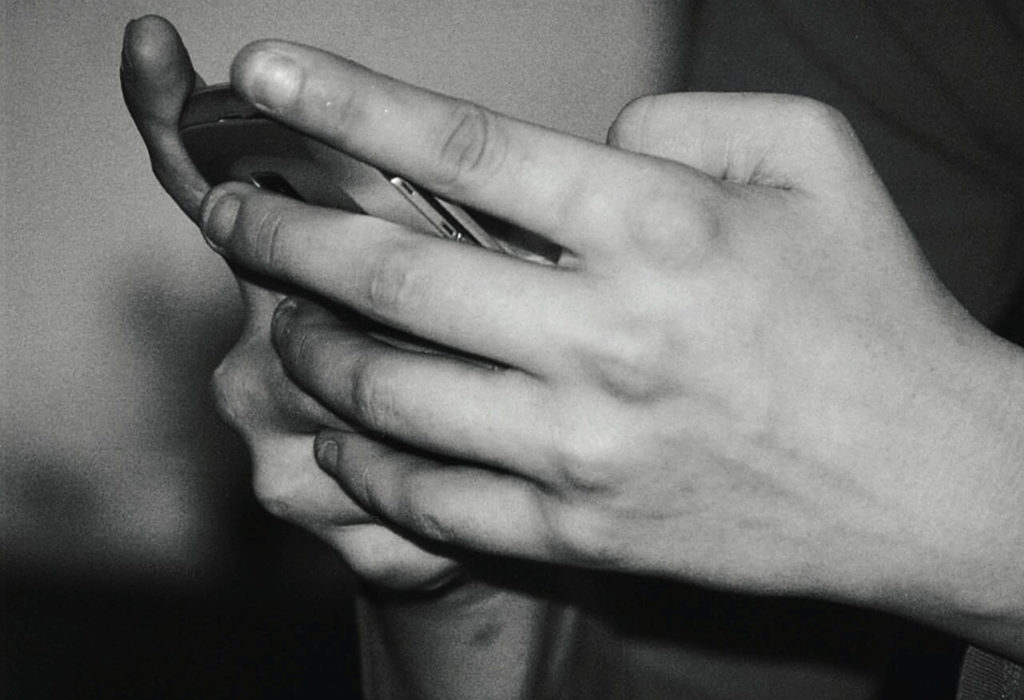Tara* and I are on the train, heading for Strathfield, talking about sex. It’s late at night and we’re alone, save for a worried-looking grandma. Safe in her shawl, grandma listens quietly, maybe wondering what all this ‘sexting’ business is about.
Neither of us have the heart to tell her that, at best, sexting can be a mutually pleasurable way of flirting. Explicit, sure, but exciting all the more. At worst, sexting doesn’t feel good, isn’t consensual, or is outlived by the permanent consequences of sexting gone wrong.
Tara, 22, counts herself lucky that her own naked pictures are still being kept safe within the boundaries of her relationship. “My boyfriend says his friends show him the sexy photos they receive,” says Tara. “I don’t like it at all – it is basically cyberbullying. But what can I do? I just told him that I don’t want to know.”
Her frown is a heavy one, with no single source: should she be jealous that her boyfriend enjoys these photos, distressed that he appreciates these show-and-tell sessions, or worried about her own photos? She doesn’t think that her boyfriend “returns the favour” to his mates and shares her nudes behind her back. From what she says, though, the thought has made the rounds in her mind.
“Some people use WhatsApp and Facebook Messenger; I only ever use Snapchat.”
Photos sent over Snapchat self-destruct within ten seconds, and if the recipient takes a screenshot before the timer runs out, the sender will know. Using Snapchat to sext is the digital equivalent of flashing: you choose who to show your naughty bits to, and most importantly, for how long.
But, as I learned from Tara and other girls later on, there are third-party apps that can sneakily save your Snapchats.
She’s disturbed, and rightfully so. “It’s terrible and unethical! Even prostitutes don’t let you film them.” She wasn’t only making the point that you can have intimacy without making a recording of intimacy; from what Tara saw, it was easier for a sex worker to say no to a client than for a girlfriend to draw boundaries with her partner.
The train doors split open and then squeeze shut. While passengers pad past, we let silence settle among us. Tara turns to her phone, typing out a text. Suddenly, it hits me that she can spill her heart to a stranger on a train like me, because the stakes are low. If she decided she didn’t want to talk to me – if she didn’t want to do what I wanted us to do – I wasn’t going to pout or put pressure on her until she caved. She could be herself, unfiltered and unadulterated.
As we leave the train cabin, she turns to tell me how her boyfriend used to pressure her for sexts which she didn’t want to send, and then, after she had given in, for sex itself. “So in Year 11, I lost my virginity. To him.”
Her parting words are that having sex makes it hard to break up because of the strong emotional bonds it can create. It takes a while for what she says to sink in: she’s thought about leaving her boyfriend before.
The landscape of teenagehood is a complicated one. Movies like Mean Girls dramatize the schoolyard shenanigans of socially-conscious teens, but they’re really not too far off the mark. At that age, more than any other, fitting in and standing out ranks pretty damn high on the wish list.
After the train trip with Tara, I was curious out to find out how other teens feel about sexting. I discovered the snapping and sending of sexy photos is something that one in two teenagers do. The Australian Institute of Criminology (2015) found that 67 per cent of teens have received sexually explicit photos.
“Everybody is sexting,” Aileen, an 18-year-old, told me. “And if you tell us not to, then I’m going to do it right next week!”
Aileen was with two other friends when she said this. They smirked. They were skipping school that day, all bursting to share the latest gossip, starting with the news about a “generally anti-social girl” from their school. Just last month, she sent explicit photos of herself over Facebook Messenger; she was “proud of it” but now gets “super ostracized”.
“Oh and a bunch of guys got suspended for sharing naked photos in a group chat.” Apparently, the boys got busted because somebody’s parents found out that their daughter’s boyfriend had naked photos of her in his phone.
New media technology is something that teenagers hold onto tightly. It’s here to stay, as any parent seeking to enforce a digital curfew can tell you.
On the basis of this, a new focus on Digital Citizenship was introduced to the NSW curriculum from 2011. Lessons in the classroom on cyberbullying and digital civics were brought to teenagers, many of whom already had their own first-hand experiences.
It wasn’t long before educators started to conduct lectures on the risks of sexting, focusing on its emotional, social, and legal costs. What the teens heard, however, were attempts to shame and shock them into abstinence. Most messages from adults acknowledged none of the motivations behind sexting, and all of its nightmarish terrors.
Huang, 15, explained her frustration: “If you just tell us ‘No’, we’ll be like ‘Uh…why not?’ You can’t just say sexting is stupid and ignore why we do it.”
Clearly, a blanket statement on the evils of teenage sexting was not going to fly. Especially when, as one teenage boy told me, “sexting can make you feel good… it’s biological.” My interview subjects rallied around the idea that sexting was a natural outlet for sexual curiosity. More than anything, they agreed that sexting was a way to get attention and validation: being talked about was better than being a nobody.
As Lizzie, 17, explains, “People are doing it because of ‘coolness’, but you never know if they’re actually doing it or just saying it.”
It’s no big deal to divulge personal information nowadays: social media basically runs on self-exposure. The sharing of ourselves in bits and bytes is normalized, and we don’t find it bizarre that we make objects of our bodies with our front-facing camera phones. Heck, we’re even rewarded for letting ourselves be watched, our photos and posts earning us likes, hearts, and follows.
Try it yourself: upload photos of yourself in a #bikini, under the #sun at #Bondi, and you know your Instagram posts will bring in attention in spades. Most people, especially savvy teenagers, know the rules of the game and the poses of this performance. But the external validation juice can be hard to turn down.
Brianna, now 18, was 14 years old when a friend of a friend drew her into her first sexting encounter. She had never met him in real life, but she will never forget him. Let’s call him Zach. Zach was just a year older, but already way more charismatic than any of her schoolmates. Reasonably attractive too, at least from the photos on his Facebook profile. One day, he asked to move their conversation to Snapchat.
Why not? She gave him her username.
They fooled around with the stickers and special effects filters on Snapchat. “What are you doing now?” he liked to ask. “Show me?”
Usually, Brianna would pick up whatever piece of homework she was poring over, hold it to her face, and take a sad selfie or a sarcastic one: “Monday funday ;)” read the caption on one. Once, after she replied that she was in bed and super bored, he asked to trade photos.
“I thought he liked me,” Brianna says, “So I sent some not-too-showy pictures hoping he would like me more.” In the time it took for a single deep breath, Zach replied, “Nice shorts. But how about your panties?”
Brianna needed time to think over her reply. She put her phone away, face-down, thinking to let Snapchat’s message notifications flood her screen. What was the lesser of the two tragedies: refusing him and losing him, or retaining his affections with a view that any fellow beach-goer would be privy to anyway?
When she finally flipped her phone around, there were no messages, no Snaps, from Zach. She could, however, see that he was online, thanks to a tiny blue dot in the bottom left corner. Gingerly and resolutely, Brianna ended the silence.
It worked, kinda. Except that in place of silence came the start of a relentless buzzing. “After that, he started asking for a full nude. He just kept on asking, giving all kinds of… reasons. I felt so uncomfortable, but he finally convinced me to send a full nude.”
Legally speaking, both of them could have gotten into serious trouble: in New South Wales, minors who consensually produce sexual images can be charged with the possession of child pornography – even if the images are for their own use. It’s especially tricky for 16- and 17-year olds, who are above the age of consent, but are not allowed to make recordings of the activities they are legally allowed to do. If prosecuted, Zach and Brianna herself could be placed on the sexual offenders register.
Brianna was distraught. Her exchanges with Zach were no longer fun or exciting, but scary and out of control. Somehow, a juvenile she had never met was hassling her to expose all for him. And he wouldn’t stop asking for more.
“When I refused to send more nudes, he didn’t reply. Not in words.”
Her naked photo popped up on her screen, and it felt like a slap in the face. She was so sure that there hadn’t been any Snapchat alert saying that he had taken a screenshot of that one nude photo she sent him. It could only mean that he had used some other app, like Snapsave, to secretly keep a copy for himself. Far from being ashamed of his trickery, Zach used it as a threat: “This is gonna get on your Facebook wall if you don’t send more photos.”
Enough was finally enough. Pushed into such a corner, Brianna put her foot down and had a go at him. “In the end,’ she concludes, “everything was fine.” She doesn’t know if he’s learnt his lesson, but she knows she will never, ever show her face in a picture again.
“It was my first experience sending images and I was blackmailed with them.”
That was the grim ending to her sexting awakening, but things could only get better from here. The perks of sexting just couldn’t be tainted by one shameful boy.
“The fact that you can do it without having to go out and see somebody is the best,” admits Brianna. “It’s a lot less daunting than encounters in person because you can better control how you look on screen and it’s very pleasing to a girl to be complimented on how she looks.”

Photography by Aisha / EyeEm
Continued from the print edition.
Caroline, a school counsellor who prefers to be identified by her first name only, says, “What worries me as a psychologist and I’m sure is the same for a lot of people is that while the kids have the digital expertise, they don’t have the emotional maturity; they don’t actually know what they’re doing… In the same way that while kids may be able to physically drive a car, we don’t let them behind the wheel. And it’s much the same with sexting.”
From her perspective, “Body image is probably the most relevant [harm sexting is having on young people].”
But returning to her car metaphor, Caroline also says, “It’s the same with anything. If you look at drugs or smoking or cars or anything they know all that stuff [cyber safety education], but it’s the fact that when they’re doing it, it’s actually fun. I mean that’s really what it comes down to, I think: it’s fun, and it gives laughs and it gives responses, you know, usually positive at the time.”
Ms Gillian Maury, a veteran school counsellor in Petersham, frames it this way: “In the first place, teenagers are often risk-takers,” she explains, “and sexting is just another risk-taking behavior.”
With more than 30 years of experience, she’s seen how growing up on social media consumes a lot of teenagers’ time while increasing their stress levels. Of course, it’s not only the teens that get stressed out.
“Parents are usually horrified and disbelieving when they hear that their child has been sexting,” she tells me. Sometimes, it’s not only out of a protective fear that a parent might feel this way. “Many parents feel threatened when their children show that they are sexual beings.”
While it’s true that teenagers are less worldly and more innocent than they think, Ms Maury thinks that parent education is also needed so that children’s online activities can be understood and supported. “After all, sexting is an extension of the old flirting, while being linked to control,” she concludes. “In general, teenagers are exploring their sexuality at a time when their hormones are highly charged. That’s all normal.”
Social media and smartphones truly change the prospects and possibilities of sexual exploration for teenagers who don’t have their own apartments for privacy. That said, we can’t simply point fingers at new media technology and say it creates sexting. No doubt it makes sexting possible – but supply is nothing without demand.
Three times as many girls than boys say that “pressure from their partner” as well as “pressure from friends” is why they send a sext. Ask, pester, and ye shall receive?
From the motivations behind sending a sext to the fallout when sexts get leaked, sexting isn’t the same for girls and for boys. “You get heaps of jokey dick pics from guys, for no reason,” a 17-year-old female student told me, “but hardly any girl randomly sends a nudie.”
That may be because once sent, the places that the intimate image can travel to are beyond the sender’s control. “Disappearing media never really disappears,” agrees Julie Inman Grant, the Australian Children’s eSafety Commissioner.
The eSafety office knows all about Snapsave and how it’s been used in cases of revenge pornography. “Sextortion—whether implicit or explicit—is never acceptable.”
To be safe from the chaos of crazy ex-partners, stolen phones, or leaked images in the first place, Commissioner Grant suggests using the Grandma Test: “If you don’t want your grandma seeing it, don’t send it.”
In a perfect world, a sext is a secret between you and I, and is consensually produced without any coercion, whether overt (for Brianna) or covert (for Tara).
Try as we might to develop digital ethics in our students, the school of life reminds us that our best efforts cannot fix the worst of what’s out there, and that the world as it is, isn’t fair.
For the girls who selectively send sexts, the experience can take a traumatizing turn in ways that boys seldom experience.
Just last August, news hit that the Federal Police had trouble taking down an online forum that gathered pornographic photos of Australian high school girls. The website domain was hosted outside of Australia, and it wasn’t so easy to have it removed. With over 2,000 photos exposing girls from more than 70 high schools, the boys and men contributing to the site congratulated themselves on their “wins”.
Many of the photos were selfies. Their sunny smiles suggested the girls had no clue their photos would be abused in such a way.
When one girl confronted the men with how their actions were making young women “suicidal”, the Sydney Morning Herald (17/08/16) reported that a user cheerily told her “not to be a slut” and that “once a photo is on Snapchat or the Internet, it belongs to the Internet”.
Clearly, the perpetrators would have it that we blame the girls whose trust was betrayed. But these girls aren’t the ones publishing private images without consent and with deceit. Blaming them is like blaming the pedestrian crippled in a hit-and-run because they expected the driver to stop, not accelerate, at the red light. It’s not a mistake to expect drivers to value human life. Neither is it naive to expect respect and dignity from fellow human beings.
If we’re feeling generous, we can allow that no decent person would willingly and knowingly embrace misogyny, toxic masculinity, or inhumanity. We can rehabilitate those who do, and show them there are other ways to deal with the senselessness inside themselves, instead of taking it out on others.
Ultimately, these crimes aren’t committed by fairytale trolls in pages and pixels, but by people that we live with, eat with, and share postal codes with.
School counsellor Caroline says “there’s no point in addressing it [the sexting issue] just from the girl’s point of view”. “For [young boys] it’s about peer pressure, it’s about showing other guys what they’ve had access to: ‘Look, this girl has shared this with me’. So they may not be intending harm, but it’s about trying to get the counterbalance.”
For both teenage girls and boys there’s a lack of awareness. “I don’t think they even understand the just breadth of the information spread, they just haven’t got that development to be able to do it.”
The following afternoon, surrounded by commuters at Central Station, I meet with a young man, neat in his blazer, his black shoes glistening from an unexpected downpour. As blankly as he could, James, 15, filled me in on the things he saw in school.
“What some guys will do,” he explained, “is they’ll ask girls non-stop. If she says no, he’ll wait a bit and ask later, until she says yes. Sometimes the girls will say yes just to get the guy to stop, and once he’s got her pic, he moves on.”
James wasn’t done. “What other guys will do is, they’ll find out from their mates who’s been sending pics. So when guys know that this girl has sent one, they ask her to send them one too. ‘Hey, I know you sent it to my mate, why can’t you send it to me too?’ is what they’ll use.”
“I don’t really know why it works,” he shrugs.
It’s a disturbing conversation. Caroline’s observations as a counsellor hint at the only antidote: “It’s really about those curious conversations you have with kids, which I find, even as a counsellor, engages the kids – because I am not the expert. They are the experts on the digital age. I’m not the expert on how they feel about their bodies…” she says, admitting her own frustrations with not just “having that conversation over and over again” and “the devastation it causes. I see kids who are really good kids and they’re really trying just to keep their life on track, and it doesn’t take much to send them off track”
From a parent, a teacher, any concerned adult’s point of view, “It’s about thinking, how can I help kids, particularly girls, learn to appreciate themselves – and that’s a hard ask, I mean that’s a whole other article in itself – how to appreciate themselves without putting themselves on the line because the pressure says you’ve got to do x, y and z.”
What’s being done, and what to do:
Within the Personal Development, Health, and Physical Education (PDPHE) subject, schools are covering topics such as cyber safety, sexual harassment, and gender equality. Digital Citizenship has also been introduced to the NSW curriculum, inculcating responsible use of technology and online behavior.
Other educational initiatives include ThinkUKnow, Australia’s first and only national crime prevention program, as well as Violence Against Women: Let’s Stop It From The Start, a national campaign advocating respect for all, regardless of gender.
The Office of the eSafety Commissioner had previously launched a cyberbullying complaint platform in July 2015, and is currently building a national online complaints portal. This will allow Australians to report image-based abuse, as well as provide immediate and tangible support such as making websites take down non-consensual pornographic images.
Names of all people who describe their experience of sexting have been changed.
An additional interview with the school counsellor identified as ‘Caroline’ was conducted by Matilda Gould.





